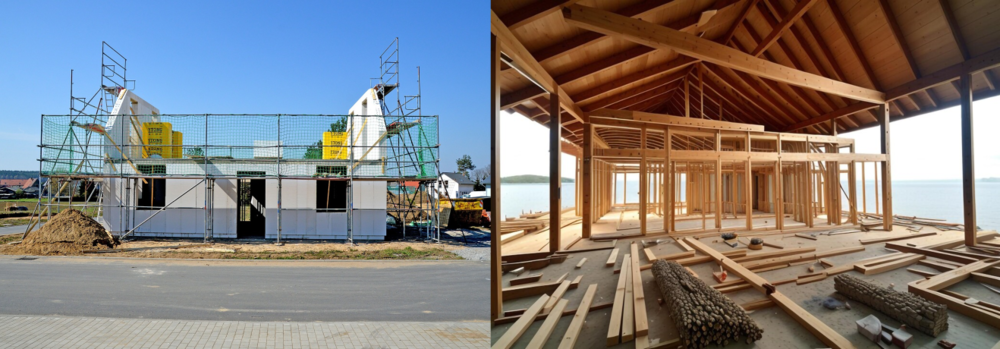It might seem daunting, time consuming & prohibitive for smaller practices, to implement BIM. Not with Driving Vision!
This article is part of a blog series exploring how Prefabrication and Modular Construction change the way structures are built.
While it has been insignificant compared to the entire construction market, the modular construction industry has experienced rapid growth in the past few years. Search interest in “Modular Construction” is up 142% over 5 years.
Let us explore the advantages of using prefab and modular construction in association with BIM.
The differences between prefab and modular, and why you should use these techniques.

It is a mutual understanding in the construction industry that prefabrication and modular constructions should be used. Research from Dodge Data & Analytics on BIM and Prefabrication reports that contractors around the U.S. see excellent value from these methodologies, as they:
Prefab and modular construction make businesses more competitive as it allows them to:
Below we talk about the main advantages of using these techniques.
Activities on traditional construction sites can be chaotic and risky. Managing safety in these conditions can be a nightmare and construction accident rates are quite high due to the:
In a prefabrication and modular environment, you have greater control over these risks, making the work environment much safer.
The safety benefits include the following:
— it reduces the physical impact on workers, as most of the work is performed in a manufacturing environment with machines — it mitigates risk associated with lifting heavy materials — it ensures the structural integrity and durability of a building as joints are cut in the factory — it prevents lassitude-related accidents — it diminishes fall risks and other dangers induced by rough weather.
Working with prefab and modular construction allows you to meet deadlines, with a good degree of certitude and reliability, mitigating the risks of high penalty costs associated with project delays.
Lean manufacturing best practices in automated, streamlined, controlled processes, avoid delays and eliminates the risk of:
A reliable schedule results in manageable organization, material delivered to site in less time, and higher profitability.
In the Dodge Data & Analytics on BIM and Pre-fabrication study cost predictability is one of the top advantages of prefab & modular construction. 71% of the survey participants reported a site logistics cost reduction.
Pre-planning using Building Information Modeling (BIM), modular construction, and prefabrication, helps save money by:
The technologies in prefab and modular construction connected to BIM improve communication.
Lean manufacturing best practices used in the fabrication shop, coordinated with on-site activities, help to:
Lean manufacturing methods and advanced technologies reduce the project time cycle by:
The main benefits of prefab and modular construction methods in managing a project are:

All modular buildings are prefabricated buildings.
Prefabricated structures are:
Modular construction requires the following rules:
Now, let us explore the differences between prefab and modular:
In modular construction, the modules are built in the factory and transported to the construction site.
Prefab panels are shipped to the site and contractors assemble them on-site.
Manufactured homes and other prefabs only need to meet public housing occupancy guidelines.
Modular buildings must pass the same building codes as traditionally built structures.
Prefab buildings have less strength and durability than modular structures. They are:
Modular constructions are more robust solutions. They:
Manufactured homes and other prefab buildings are not considered true real estate, they are considered private property, the same as your vehicle. They depreciate more rapidly.
Modular buildings are considered real estate. The Global Modular Construction Market was valued at US$ 94.8 billion in 2022 and the forecast is that it will reach US$ 155.9 billion by 2031. The global industry is anticipated to expand at an average annual rate of 5.8% between 2023 and 2031.
Modular buildings provide more design and style freedom, they look identical to frame-built structures.
Prefab buildings have modern appearances and styles thanks to their fixtures and fittings.

Modularized and prefabricated constructions are a way to minimize inefficiencies in the construction industry.
The biggest issue in the AEC industry is the amount of waste generated. Modular construction and prefabrication allow you to recycle leftover materials and reduce waste.
Shifting from traditional sites into factories with off-site manufacturing-style production, whenever possible, will improve your bottom line.
The designers' respondents to the 2020 Dodge data analytics survey predict that the overall number of future prefabrication and modular construction usage will not increase, but the percentage of projects using panelized modular construction will grow. Contractors show the most future growth.
The most used panels and modules according to the Dodge data analytics report are:
Full volumetric is a project type used less than panelized modular construction but future predictions of use are strong.
The three types of full volumetric modules currently in use are:
About three-quarters (68% to 83%) of the company types surveyed, reported some use of factory-made turnkey buildings like bathroom pods, utility rooms, etc. over the last few years.
Trade contractors forecast the highest growth rate of usage. 31% predict they will use them on 25% or more of their projects in the next three years, compared with only 10% currently at that level.
29% of all company types will be implementing factory-made turnkey building units on at least 25% of their projects.
The Modular Building Institute defines modular structures as:
structures that are designed to be reused or repurposed multiple times and transported to different building sites.
Once considered a second-class solution, for properties in lower-priced areas, modular construction is no longer considered a cheap solution.
With the development of modern technologies, economic demands, and owners changing their views, the interest in modular construction is increasing around the world. Some examples are:

Using prefabrication and modular construction will help you to:
Speed up the construction process. With modular construction, the foundation, and the building can be built at the same time. The average reduction in the entire process in factory-based prefabrication is 20 to 30 percent compared with traditional construction. The Chinese city of Wuhan built a hospital in just a few days, using these techniques, to treat patients suspected of contracting the coronavirus.
Improve return on investment. In prefab and modular construction, costs are predictable, allowing you to plan your budget appropriately at the beginning of the project, rather than just having a rough estimate. The prefabricated structures allow you to have your building constructed sooner than on-site construction projects, so you can open your business's doors sooner and begin making profits earlier.
Cut costs. A shorter build time is the main driver to save money. Another factor is that the labor costs are cheaper, as in prefabrication you are using factory workers rather than individual tradesmen like plumbers and electricians. Limited interruptions, due to weather-related issues as the teams work inside, enables them to work even in inhospitable weather conditions. Building materials are stored inside and stay cleaner as they are protected from the elements.
Decrease site disruption. With modular construction you can keep your site open longer when constructing, keeping your client's business running or their activity flowing. When a factory, in Wales realized that a traditional site-built project could block its only shipping entrance for nine months, they decided to go modular. They were able to complete delivery and installation in a few weeks and the entrance was out of service for less than a day.
Reduce pollution. In modular construction, materials are delivered to a factory, lessening the number of vehicles going to site which reduces air and noise pollution.
Minimize waste. Using lean manufacturing methods in modular factories, you reduce waste making it easier to recycle construction material and use environmental principles during construction.
Facilitate quality control. The modular method of “in-house” design and production reduces clashes and helps designers, engineers, and builders to spot and correct problems at the design stage, avoiding costly reworks.
Driving Vision's technology appraisal looks at the best way to insert new technology in your workflows and how to move your organization to cloud computing, so you can open up new possibilities for your daily planning tasks and make sure your data never leaves the optimally secured data center.
A Driving Vision expert will conduct the interviews online and will discuss with you the issues and our findings in the report. Together we will decide the best way to implement the solutions at your pace and according to your budget.
Implementing BIM can be daunting, but Driving Vision is here to help you at the pace you are comfortable with. Get started by getting in touch now
Of practices using BIM made positive ROI
Of practices using BIM improved health and safety
Of practices using BIM decreased errors and omission
Of practices using BIM enhanced their practice image
Of practices using BIM claimed less litigations
Of practices using BIM reduced rework
It might seem daunting, time consuming & prohibitive for smaller practices, to implement BIM. Not with Driving Vision!
